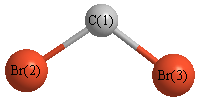Jump to
S2C1
Energy calculated at QCISD(T)=FULL/6-31G*
| | hartrees |
|---|
| Energy at 0K | -5177.967058 |
| Energy at 298.15K | -5177.972024 |
| HF Energy | -5177.522155 |
| Nuclear repulsion energy | 322.832795 |
The energy at 298.15K was derived from the energy at 0K
and an integrated heat capacity that used the calculated vibrational frequencies.
Geometric Data calculated at QCISD(T)=FULL/6-31G*
Point Group is C2v
Cartesians (Å)
| Atom |
x (Å) |
y (Å) |
z (Å) |
|---|
| C1 |
0.000 |
0.000 |
1.027 |
| Br2 |
0.000 |
1.565 |
-0.088 |
| Br3 |
0.000 |
-1.565 |
-0.088 |
Atom - Atom Distances (Å)
| |
C1 |
Br2 |
Br3 |
| C1 | | 1.9212 | 1.9212 |
Br2 | 1.9212 | | 3.1293 | Br3 | 1.9212 | 3.1293 | |
 More geometry information
More geometry information
Calculated Bond Angles
| atom1 |
atom2 |
atom3 |
angle |
|
atom1 |
atom2 |
atom3 |
angle |
| Br2 |
C1 |
Br3 |
109.058 |
|
Electronic energy levels
Charges, Dipole, Quadrupole and Polarizability
Jump to
S1C1
Energy calculated at QCISD(T)=FULL/6-31G*
| | hartrees |
|---|
| Energy at 0K | -5177.942668 |
| Energy at 298.15K | -5177.947682 |
| HF Energy | -5177.539325 |
| Nuclear repulsion energy | 315.252075 |
The energy at 298.15K was derived from the energy at 0K
and an integrated heat capacity that used the calculated vibrational frequencies.
Geometric Data calculated at QCISD(T)=FULL/6-31G*
Point Group is C2v
Cartesians (Å)
| Atom |
x (Å) |
y (Å) |
z (Å) |
|---|
| C1 |
0.000 |
0.000 |
0.756 |
| Br2 |
0.000 |
1.660 |
-0.065 |
| Br3 |
0.000 |
-1.660 |
-0.065 |
Atom - Atom Distances (Å)
| |
C1 |
Br2 |
Br3 |
| C1 | | 1.8519 | 1.8519 |
Br2 | 1.8519 | | 3.3202 | Br3 | 1.8519 | 3.3202 | |
 More geometry information
More geometry information
Electronic energy levels
Charges, Dipole, Quadrupole and Polarizability
